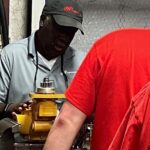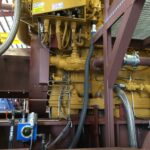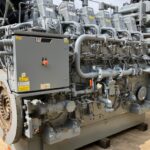
Number 1: Starting sequence initiated while starter or engine is still rotating
Air starters and engines have run-down times. Depending on the type of starter it can take several (5 to 20) seconds for an air starter to come to coast to a complete stop. Larger displacement engines can also require several seconds to come to a complete stop. A rotating gear has trouble meshing with a stationary gear. Two rotating gears will have double the trouble.
Result: Broken or chipped drive gear pinion
Result: Damaged starter clutch
Result: Broken or sheared starter drive shaft
Fix: Always wait at least 30 seconds to initiate a cranking sequence following an aborted or failed start. Make certain that the engine and the starter are at complete stop.
Number 2: Hard Crank Cycles
In ideal conditions, well-tuned engines will start quickly. Sometimes ideal conditions don’t exist and hard cranking cycles (20 to 90 seconds) are needed to get the engine running. Modern air starters are designed to handle these circumstances, but they can still overheat. Internal overheating will adversely affect vanes, bearings and transmissions. Signs are pinion wear signatures. Heat signatures . Vanes can get hot enough to scorch or burn. Bearing over-heating can cause the bearing failure, resulting in the starter motor seizing.
Result: Scorched or burned vanes that wear prematurely, break, splinter and will lock-up the air motor
Result: Drive bearing failure causing scorched or broken shaft.
Result: Turbine shaft bearing failure causing bearings to disintegrate and seize the turbine motor
Result: Pressure signature and gouging of drive pinion prevent smooth flywheel engagement
Fix: If engine fails to start, allow 2 to 3 minute cooling time before initiating cranking cycle again.

Number 3: Contaminated Air/Gas Stream
Clean air or gas will help keep air starters running smoothly for years and years. Modern air starters can tolerate limited amounts of dirty air such as water, oil, fluids, fine dirt, rust and other contaminants, but eventually a toll will be taken.
Result: Eroded or deformed turbine rotors and nozzles
Result: Stuck vanes
Result: Damaged motor bearings and metal components
Result: Relay valve mechanism stuck or causing internal bleeding
Result: Starter drive control lines and control ports clogged, causing starter drive to fail to engage the flywheel
Result: Starter drive permanently stuck in flywheel, causing drive mechanism to continuously turn with a running engine
Fix: A) If a new install, blow out piping with air to remove welding slag, dirt and rust before attaching starter. B) Install Y-strainer and mesh airline filter. C) Drain airlines prior to starting. Especially, if starting system has been idle for long periods. D) Clean and blow out control lines and ports. E) Be sure to orient the starter exhaust downward, so any fluids or debris can escape easily.

Number 4: Insufficient and Pulsating Air/Gas Volume
Air/gas pressure (psi/bar) is vitally important, but air/gas volume is often the real culprit when air-starting engines.
Result: Low starting power output
Result: Pulsating volume caused by obstructions and unnecessary piping elbows can damage starter transmissions and result in failed starts.
Fix: A) Consult manual or manufacturer for correct supply line size. B) Eliminate piping elbows. C) Check the exhaust port and piping for obstructions like ice, too small piping, and eliminate 90 degree elbows.
